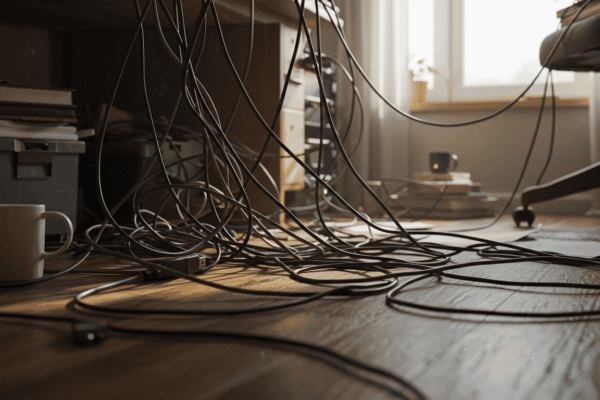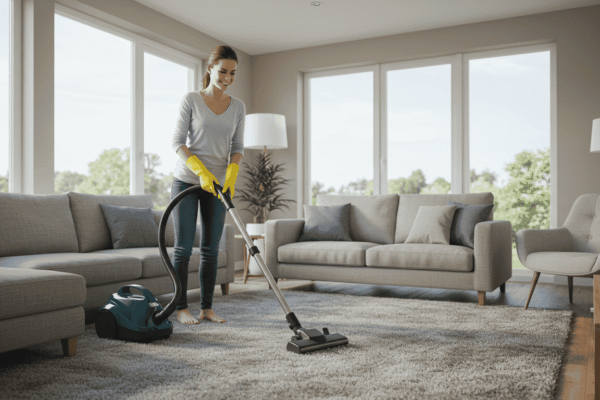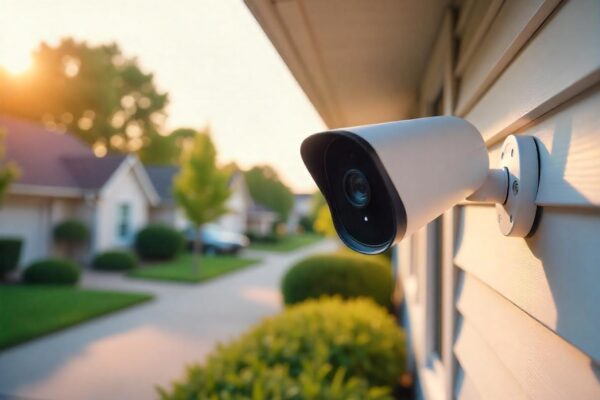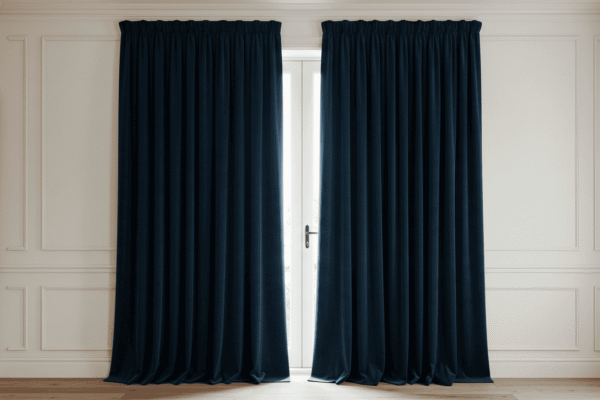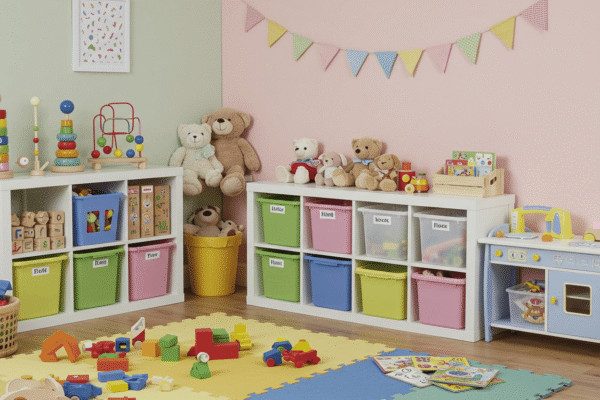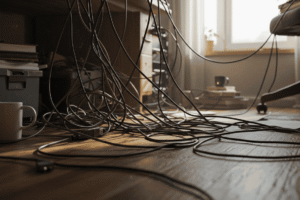Clogged drains are one of the most common and frustrating household problems that can slow down your daily routine. Whether it’s a slow-draining kitchen sink or a completely blocked bathroom drain, knowing how to fix clogged drains at home can save you time, money, and stress. In this guide, we’ll walk you through simple, effective tips and tricks to unclog drains at home using tools and ingredients you probably already have. Say goodbye to harsh chemicals and expensive plumber visits—let’s get your drains flowing freely again with easy DIY solutions!
Understanding What Causes Clogged Drains
Clogged drains can be a nuisance, but understanding what causes them is the first step toward preventing and fixing the problem effectively. By identifying the typical reasons behind a blocked drain, you can better target your cleaning efforts and avoid frequent plumbing headaches.
Common Culprits Behind Drain Blockages
Most clogged drains result from everyday materials that accidentally find their way into your pipes. Hair is one of the biggest offenders, especially in bathroom drains, where it easily accumulates and forms dense clumps. Grease and oil from cooking are notorious for solidifying inside kitchen pipes, creating stubborn blockages. Soap scum combines with minerals in water, sticking to pipe walls and narrowing the flow over time. Lastly, food particles and debris left in kitchen sinks can get trapped and cause slow drainage or full clogs if not properly rinsed away.
How Drain Clogs Develop Over Time
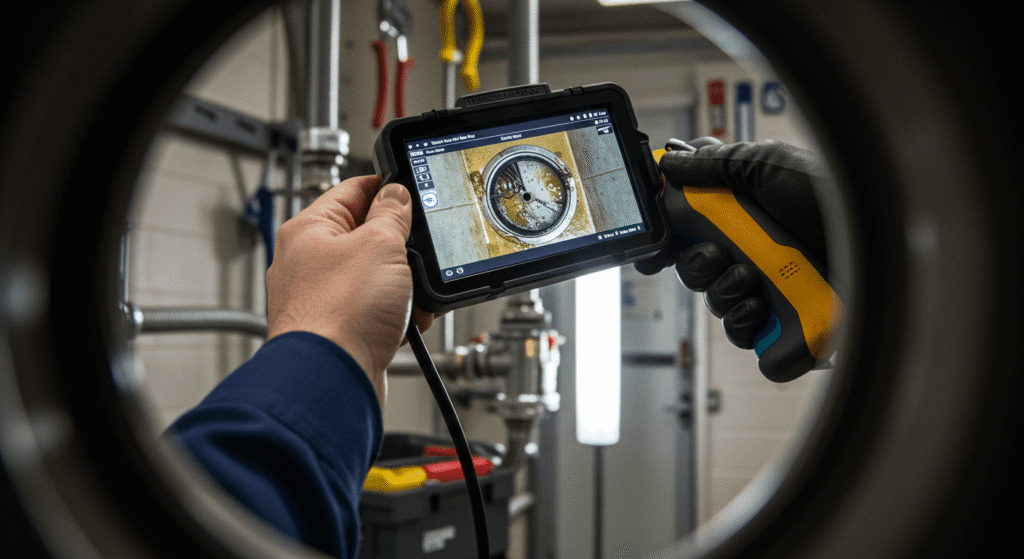
Drain blockages rarely happen overnight. Instead, they form gradually as these materials build up layer by layer inside the pipes. For example, grease starts as a liquid but cools and hardens against pipe walls, catching other debris along the way. Hair and soap scum often combine, creating a sticky mass that further traps dirt and particles. Over weeks or months, this accumulation restricts water flow, leading to slow draining and eventually complete blockage if ignored.
Quick Self-Check: Signs Your Drain Is Clogged
Recognizing the early warning signs of a clogged drain can save you from more serious plumbing issues. If water drains slowly or pools in your sink or tub, this indicates partial blockage. Foul or unusual odors coming from drains often suggest trapped debris and bacterial buildup. Gurgling sounds during drainage are another clue that air is struggling to pass through a clogged pipe. Noticing any of these symptoms means it’s time to take action before the clog worsens.
Engagement Element:
| Common Clog Cause | Kitchen Drain | Bathroom Drain | Laundry Drain |
|---|---|---|---|
| Hair | Low | High | Low |
| Grease | High | Low | Low |
| Soap Scum | Medium | High | Medium |
| Food Particles | High | Low | Low |
| Detergent Residue | Low | Medium | High |
This table highlights which clog causes are most common for different drain types, helping you pinpoint likely problems based on your drain’s location.
The DIY Drain Cleaning Toolkit: What You Need at Home
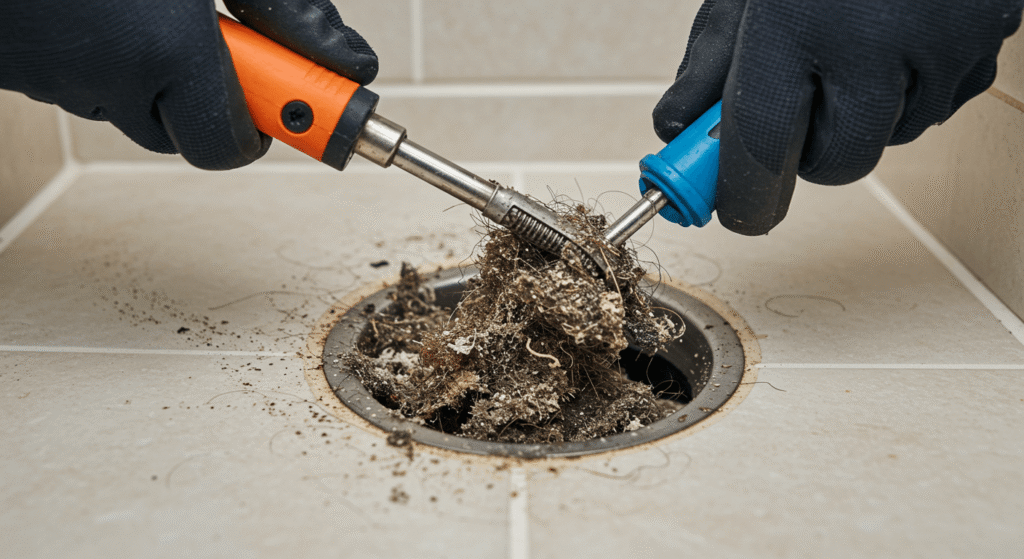
Having the right tools and ingredients on hand makes tackling clogged drains at home much easier and more effective. Before calling a plumber, you can often resolve the problem yourself with simple items found in most households. Knowing which tools to use and when to use them can save you time, money, and frustration.
Essential Tools for Unclogging Drains
A few basic tools go a long way when dealing with clogged drains. A plunger is often the first and most accessible tool to try — it uses suction to dislodge blockages. For tougher clogs deeper inside pipes, a drain snake (also called a plumber’s snake) can reach and break up debris that a plunger can’t touch. A pipe wrench may be necessary if you need to remove trap pipes to clear stubborn blockages manually. Having gloves, a bucket, and a flashlight nearby can also help keep the process clean and safe.
Safe Household Ingredients That Work Wonders
Natural ingredients commonly found in your kitchen can be surprisingly effective for clearing minor clogs. Baking soda combined with white vinegar creates a fizzy reaction that helps break down grime and loosen blockages. Pouring boiling water down the drain can melt away grease buildup and flush out loosened debris. These methods are non-toxic and gentle on your pipes, making them great first options before considering chemical cleaners.
When to Avoid Chemicals and Why
While chemical drain cleaners might promise quick results, they can often cause more harm than good. Harsh chemicals may damage your plumbing pipes, especially if used frequently or incorrectly. They can also be dangerous to handle and harmful to the environment. If natural methods don’t work, or if you’re dealing with recurring clogs, it’s usually better to call a professional plumber rather than relying on chemical solutions that could worsen the problem.
Must-Have DIY Drain Cleaning Tools & Ingredients Checklist
- Plunger
- Drain snake
- Pipe wrench
- Gloves
- Bucket
- Baking soda
- White vinegar
- Boiling water
This checklist keeps your DIY drain cleaning toolkit organized and ready for quick action whenever a clog strikes.
Step-by-Step Guide: How to Unclog a Drain Without Chemicals
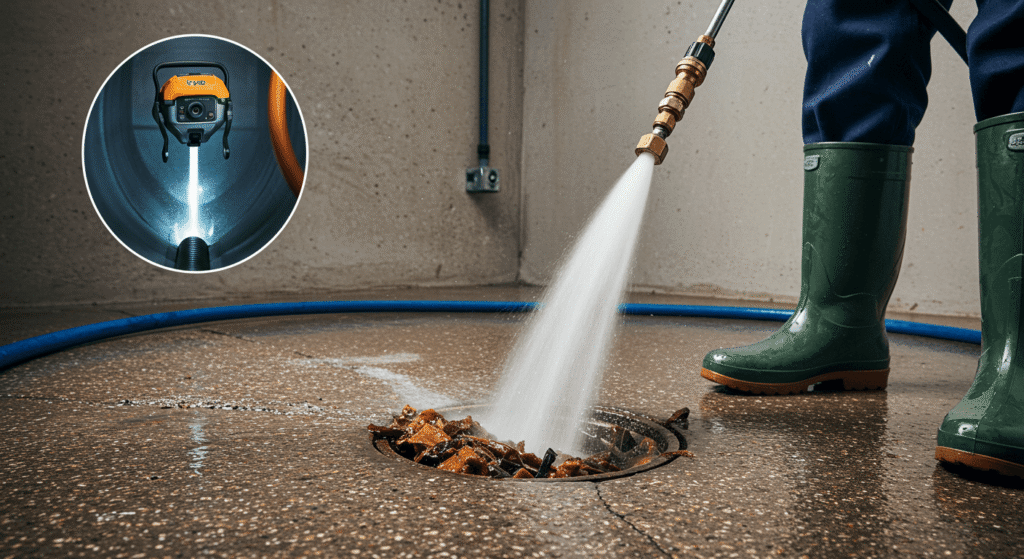
When dealing with clogged drains, using natural and mechanical methods first is often the safest and most effective approach. These techniques avoid harsh chemicals and can be done quickly with household items or simple tools. Here’s a clear, step-by-step guide to help you unclog your drains without any toxic products.
Using Boiling Water for Minor Clogs
Boiling water is a surprisingly powerful ally against grease and soap buildup. Start by carefully pouring a kettle or pot of boiling water slowly down the clogged drain. Let it sit for a few minutes to soften and dissolve the clog. Repeat the process if necessary. This method works best on slow-draining sinks or tubs caused by grease or soap residue but may not be effective for solid blockages like hair.
Baking Soda and Vinegar Method Explained
This natural cleaning duo creates a fizzy chemical reaction that helps break down grime and loosen debris. First, pour about half a cup of baking soda down the drain. Follow with half a cup of white vinegar. You’ll notice fizzing and bubbling as the two react. Cover the drain with a plug or cloth and let the mixture sit for 15 to 30 minutes. Finally, flush the drain with boiling water to wash away loosened buildup. This method is safe for most pipes and a favorite for environmentally friendly home care.
How to Use a Drain Snake Properly
For tougher blockages that don’t respond to boiling water or baking soda and vinegar, a drain snake can be highly effective. Insert the snake’s flexible coil into the drain and gently push it forward while turning the handle clockwise. When you feel resistance, you’ve likely reached the clog. Rotate the snake to break up or hook the debris, then slowly pull it back out. Repeat as necessary until water flows freely. Be careful not to force the snake to avoid damaging your pipes.
Engagement Element:
Step-by-Step Flowchart
- Step 1: Pour boiling water slowly into the drain
- Step 2: Add baking soda, then pour in vinegar
- Step 3: Cover and wait 15–30 minutes
- Step 4: Flush with boiling water
- Step 5: If needed, use drain snake carefully
- Step 6: Test water flow; repeat if necessary
This visual guide helps you follow the unclogging process clearly and confidently.
Dealing With Different Types of Drains

Every drain in your home has its unique challenges when it comes to clogged drains. Understanding the differences between kitchen, bathroom, and laundry drains will help you choose the right approach to clear blockages quickly and efficiently. Here’s how to tackle each type effectively.
Kitchen Sink Drain Problems and Solutions
Kitchen drains often face clogs caused by grease, food particles, and soap residue. Grease can solidify inside pipes, trapping bits of food and creating stubborn blockages. To combat this, avoid pouring hot grease down the drain and regularly flush the sink with boiling water to keep pipes clear. Using the baking soda and vinegar method can help dissolve buildup, while a drain snake may be necessary for tougher clogs.
Bathroom Drain Clogs (Showers, Bathtubs, and Basins)
Bathroom drains frequently clog due to hair, soap scum, and skin flakes. Hair tends to form dense mats that trap other debris, making the clog harder to remove. Regularly cleaning the drain cover and using a drain snake can prevent and clear hair blockages. Pouring boiling water occasionally helps dissolve soap scum. Avoid flushing items like cotton swabs or sanitary products that easily cause clogs.
Laundry and Floor Drains: Tips and Tricks
Laundry and floor drains can clog from lint, detergent residue, and dirt carried in by water. Since these drains often handle larger volumes of water, blockages can cause serious backups. Clean the drain traps regularly and avoid overusing detergent, which can build up inside pipes. For minor clogs, boiling water and the baking soda-vinegar method are effective, while a drain snake may be needed for deeper blockages.
Engagement Element:
| Drain Type | Common Causes | Best Cleaning Method | Prevention Tips |
|---|---|---|---|
| Kitchen Sink | Grease, food particles | Boiling water, baking soda & vinegar, drain snake | Avoid pouring grease; regular flushing |
| Bathroom Drains | Hair, soap scum, skin flakes | Drain snake, boiling water, manual removal of hair | Use drain covers; clean regularly |
| Laundry Drains | Lint, detergent residue | Baking soda & vinegar, boiling water, drain snake | Clean traps; moderate detergent use |
This table helps you quickly identify the best methods and prevention tips based on your drain type.
Preventing Clogged Drains: Smart Habits That Save You Time and Money
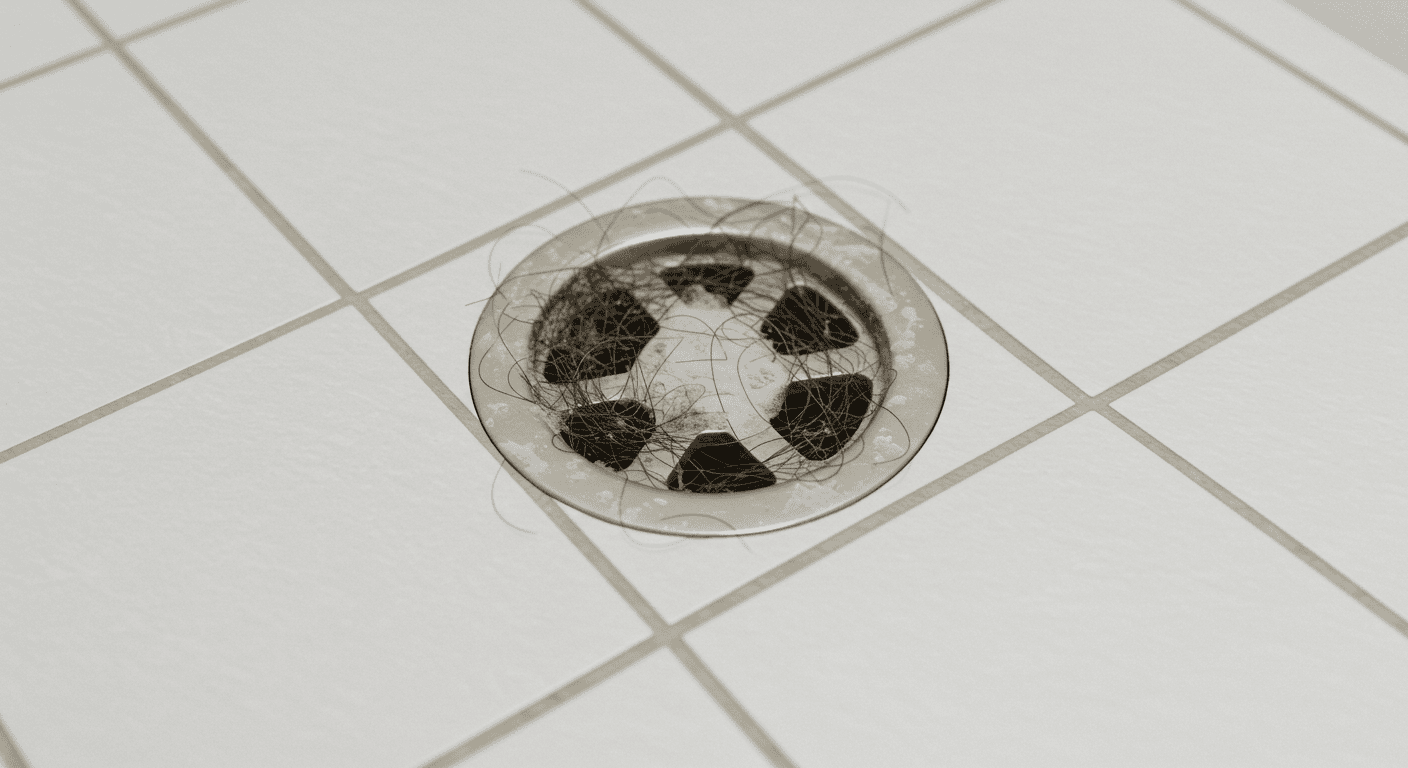
Prevention is always better than dealing with clogged drains after the fact. By adopting a few simple daily habits and regular maintenance routines, you can keep your drains flowing smoothly and avoid costly repairs or plumbing emergencies. Let’s explore practical ways to protect your home’s plumbing.
Daily Habits That Keep Drains Clear
Small everyday actions make a big difference. Avoid pouring grease, coffee grounds, or food scraps down kitchen drains—these are prime culprits in clog formation. Use strainers in sinks and showers to catch hair and debris before they enter the pipes. After each use, flush drains with hot water to help wash away minor buildup. Being mindful about what goes down the drain is the easiest and most effective prevention.
How to Maintain Your Drain Traps
The drain trap (the U-shaped pipe under sinks and tubs) plays a key role in catching debris and preventing sewer gases from entering your home. Regularly removing and cleaning the trap can prevent buildup that leads to clogs. Place a bucket underneath before loosening the trap to avoid spills. Clean out hair, grease, and gunk with a brush or cloth, then reassemble carefully to avoid leaks.
Why Regular Drain Cleaning Matters
Even with good habits, minor buildup can accumulate inside pipes over time. Scheduling regular drain cleaning—whether it’s monthly or quarterly—helps clear away grease, soap scum, and other debris before they become problematic. Consistent cleaning saves you from slow drains and sudden blockages, ultimately extending the life of your plumbing system.
Engagement Element:
Quick Tips Box: 5 Habits to Prevent Clogged Drains
- Avoid pouring grease or food scraps down drains
- Use sink and shower strainers to catch debris
- Flush drains with hot water after use
- Clean drain traps regularly
- Schedule periodic deep drain cleanings
These habits are simple to follow but highly effective in keeping your home’s drains clog-free.
When to Call a Professional Plumber
While many clogged drains can be handled with DIY methods, some situations require expert intervention. Knowing when to call a professional plumber can save you time, avoid damage, and ensure the problem is fully resolved. Here’s how to recognize those critical moments.
Warning Signs Your DIY Fix Isn’t Enough
If your drain remains slow or completely blocked after trying boiling water, baking soda and vinegar, or a drain snake, it’s a clear sign the clog is more serious. Recurring clogs, foul odors that persist, or water backing up into multiple fixtures indicate deeper plumbing issues. Also, if you notice leaks, unusual noises, or damage to pipes, it’s time to stop DIY attempts and seek professional help.
What Plumbers Do Differently
Professional plumbers have specialized tools and training that allow them to diagnose and clear stubborn clogs effectively. They use high-pressure water jetting, advanced augers, or even cameras to inspect pipes and remove blockages thoroughly. Additionally, plumbers can identify underlying problems like tree root intrusion, pipe damage, or sewer line issues that DIY methods can’t address.
Cost vs. Benefits of Professional Help
While hiring a plumber may seem costly upfront, it often saves money in the long run by preventing pipe damage, reducing the risk of emergencies, and avoiding repeated DIY failures. Professionals provide a reliable, permanent fix, giving you peace of mind. Balancing cost and benefit means calling an expert when the problem exceeds your DIY capabilities, protecting your home’s plumbing investment.
Natural vs. Chemical Drain Cleaners: Pros and Cons
When it comes to tackling clogged drains, choosing the right cleaning method can make all the difference. Natural and chemical drain cleaners each have their advantages and drawbacks. Understanding these helps you make safer and more effective choices for your home and the environment.
Effectiveness and Safety of Natural Solutions
Natural drain cleaners like baking soda, vinegar, and boiling water are gentle yet effective against common clogs caused by grease, soap scum, and minor debris. They pose minimal risk to your pipes and are safe to use around children and pets. While natural methods may take longer or require repeated applications, they help maintain your plumbing’s health without harsh chemicals.
Risks of Using Harsh Chemical Cleaners
Chemical drain cleaners can quickly dissolve blockages but come with significant risks. They often contain corrosive substances that can damage metal and PVC pipes over time, leading to leaks or pipe failure. Handling these chemicals improperly can cause burns or respiratory issues. Furthermore, chemical runoff is harmful to the environment and wastewater systems.
Eco-Friendly Alternatives
Besides traditional natural ingredients, there are eco-friendly commercial products that use plant-based enzymes and bacteria to break down organic matter safely. These options offer an effective middle ground—strong enough to clear clogs but gentle on plumbing and the planet. Choosing eco-friendly alternatives supports sustainable home care without sacrificing performance.
Engagement Element:
| Feature | Natural Methods | Chemical Cleaners |
|---|---|---|
| Effectiveness | Good for minor clogs; may require multiple uses | Fast-acting; effective on tough clogs |
| Safety | Safe for pipes, family, and pets | Corrosive; hazardous if mishandled |
| Environmental Impact | Environmentally friendly | Harmful to ecosystems and water supply |
| Cost | Low (common household items) | Moderate to high |
| Long-Term Plumbing Health | Maintains pipe integrity | Can damage pipes over time |
This table helps you weigh the pros and cons to choose the best drain cleaning method for your needs.
FAQs About Clogged Drains and Their Fixes
Dealing with clogged drains raises many common questions. Here, we address some of the most frequently asked concerns to help you maintain smooth-flowing pipes and avoid frustration.
How often should I clean my drains?
Regular maintenance is key to preventing stubborn clogs. For most households, cleaning drains every 1 to 3 months is a good rule of thumb. If your drains tend to clog frequently or you use them heavily, monthly cleaning with natural methods like baking soda and vinegar can keep buildup at bay. For light use, quarterly cleaning is usually sufficient.
Can I prevent hair clogs in the shower?
Yes! The best way to prevent hair clogs is to use a drain cover or hair catcher that traps hair before it enters the drain. Make a habit of removing trapped hair from the catcher after each shower. Regularly flushing the drain with boiling water or using the baking soda and vinegar method also helps keep soap scum and hair buildup from accumulating.
What if my sink still drains slowly after cleaning?
If your sink remains slow after trying DIY methods, the clog may be deeper or more severe. In this case, using a drain snake can help break up or remove the blockage. If the problem persists, it’s advisable to call a professional plumber who can inspect the pipes with specialized tools and address any underlying issues.
Keeping Your Home’s Clogged Drains Clear and Problem-Free
Managing clogged drains doesn’t have to be a headache. With the right knowledge, tools, and simple habits, you can effectively prevent and fix most drain blockages at home without harsh chemicals or costly repairs. Remember to act promptly at the first signs of slow drainage, use natural cleaning methods, and maintain your drains regularly to keep everything flowing smoothly. And when a clog is stubborn or recurring, don’t hesitate to call a professional for a lasting solution. Taking these steps will save you time, money, and stress, ensuring your plumbing stays in great shape for years to come.

